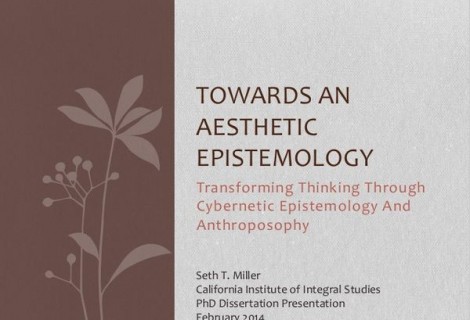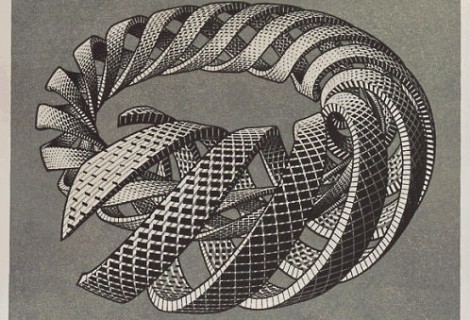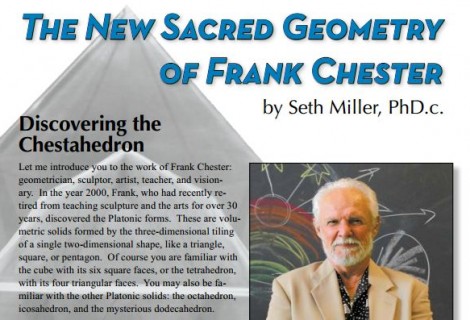An Esoteric Guide to Spencer Brown’s Laws of Form #2
« Previous Page | 1 2 3 4 | View All | Next Page »
As GSB indicates,
LoF p. 3
- What is not allowed is forbidden.
This is to say that we can only use distinctions that we make; therefore we must complexify our understanding of the first distinction: we must distinguish anew the first distinction. Glanville, with Francisco Varela, recognized this problem. They saw that it led to an infinite regress (the bane of logic, which we are supposed to avoid), and their solution was to say that “distinction cannot cleave a space, and its value must not be distinct from its mark, that is, a distinction distinguishes (is) itself.” (Glanville, The Self and the Other: The Purpose of Distinction p. 1).
Yet he notes that that the distinction, which only distinguishes itself, also implies a manifold. Actually, we see that distinction must imply a manifold (it cannot ONLY be itself distinguishing itself, simply) or existence would never have any content other than existence itself — that is, no distinction of difference beyond that of the fact that existence exists.
Thus the first distinction must be a complex distinction; it must, we could say, keep the Chaos alive, it must maintain potential in more than one way. This is to say that it must be a complex unity, a single diverse manifold.
Now we have noted that Glanville wants to say that in order to avoid an infinite regress of distinctions that never reach any value, the distinction must distinguish only itself. But we can point out that this does not actually solve the problem, it rather only is a viewing of the problem from a different perspective. He thus ends up saying that:
“If, in drawing a distinction, we do not distinguish between the mark and the value but take the value as being the mark, we have no regress. The distinction is then a self-distinction, and the value (which is the mark) is the value to the self. It is not accessible to the outsider. It remains private. We have, instead, Objects that distinguish themselves and do not cleave a space: they do not even need a space within or without. Thus, the Object (its self itself) maintains itself, but is alone. The Object is the Object is the Object” (The Cybernetics of Value… p. 5).
This is a view which is in direct contradiction to esoteric experience… but such is not the basis upon which we need to address Glanville’s idea. We can rather point out that his attempt to avoid a regress actually fails, in the sense that the regress is successfully eliminated. It is, rather, simply transformed into a recursion, which still has a ‘regressive’ nature. However, that nature is, instead of played out extensively, is played out intensively, as in a point rather than a line.
And now we can bring back in the geometric imagination from earlier, and make use of it. Geometrically, the analogy for a normal regression is that of an infinite line. But every line is ALSO a circle whose center is at infinity. One can contract that circle (the line) from infinity (extensive space / no space) into finite (intermediate / actual) space, and then contract it further until the circle becomes a point (intensive space / no space). In other words, Glanville’s choice to avoid regress is, in some sense, unnecessary; the point-like logic is a transformation of the line-like logic, through the logic of the circle. Thus we are not restricted to our interpretation of the mark, of distinction, as that which EITHER does or does not “cleave a space”: it BOTH cleaves a space and DOES NOT cleave a space, depending upon the distinction of the distinctions. That is to say, by distinguishing the original logic of the mark of GSB from the modified “möbius logic”, Glanville is led to a lower order content (the value of the distinction), whereby “the Object is the Object is the Object” is considered as a mark marking itself in a way that is inaccessible to any outsider. But this is only a part of the story that is given by the distinction between the logic of the line and the logic of the möbius, which is the logic of the intensive point. By exploring the logic of this intensive point, we can change the way we distinguish distinction.
We have seen that the infinite regress seemed to be required by the failure of the mark to distinguish itself from its value. But to try to solve this by saying that the mark ONLY marks itself, and is thus its own value, is an error. If a mark can only mark itself, it is equivalent to being valueless, even to itself, because in order for the mark to have the value OF itself FOR itself, the mark must again distinguish itself from its value, otherwise we can only say “mark” or “value”, but not both. And here is where we get, as promised, to the need to introduce the N and N+1 business referred to before, as it provides a way to think about this admittedly bizarre and obtuse problem in a way that may continue in our quest to illuminate illumination.






amazing…like you! thank you for sharing
Seth, this is so cool! Thanks for sharing it with us…..